Highlights of 2022 from the Turnbull Library’s Arrangement & Description team
The annual retrospective looking back at 2022 with observations and reflections from the Turnbull Library team who make our collections easier to find and use.
Nicola Frean — ‘Kia whakarite, kia whakamārama, kia tauhere ki te ao’
Welcome to the Arrangement & Description (A&D) team blog for 2022!
The A&D team's role is to process ‘unpublished’ or archival collections so that they are discoverable and useable. Our team whakatauākī clearly articulates what we do and why we do it. The whakatauākī, gifted by former colleague Ariana Tikao (Kāi Tahu), is Kia whakarite, kia whakamārama, kia tauhere ki te ao | To arrange, to illuminate, to connect with the world.
For me, 2022 hammered home the power and complexity of the words and systems with which we work. We contributed across Aotearoa, for example the blog post Nubian Marino iwi kairangahau 2022. We contributed internationally, for example through contributing to the publication Reimagine Descriptive Workflows: a community-informed agenda for reparative and inclusive descriptive practice. We also added Homosaurus to our indexing options — the international linked data vocabulary of Lesbian, Gay, Bisexual, Transgender, and Queer (LGBTQ+) terms.
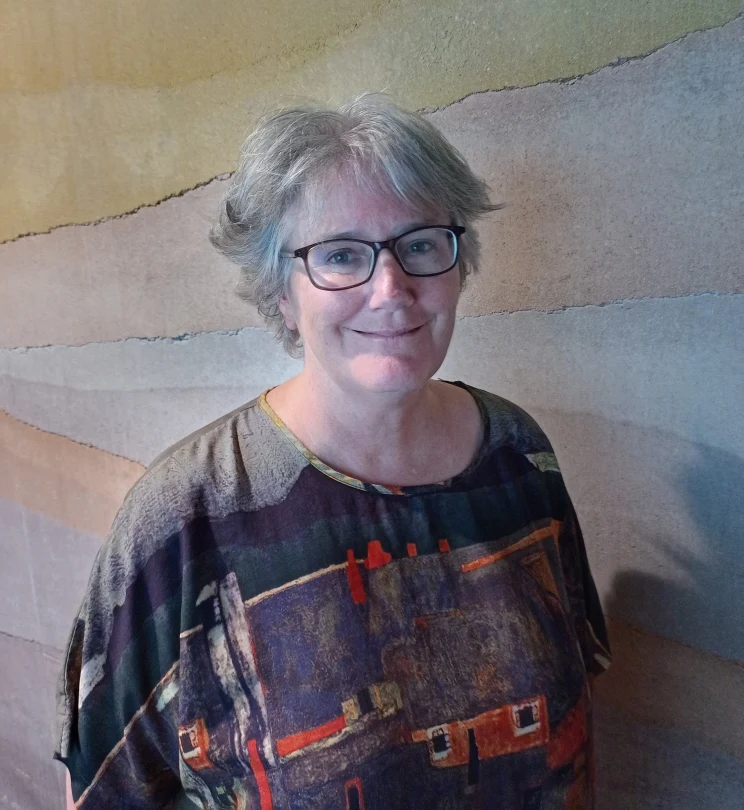
Nicola Frean, Team Leader of the Arrangement & Description team at the Alexander Turnbull Library. Photo by Rhys Owen.
Thanks to solid and thoughtful efforts, we kept our core infrastructure fit-for-purpose with new computer servers and software upgrades. We kept exploring ways to do A&D remotely, for example by increasing the Original File Prints collection descriptions that we create from digitised copies accessed from home.
Operationally, we kept supporting Ūtaina! the large audiovisual digitisation collaborative project the Library is part of. Being part of this work is a huge leap forward for discoverability, as well as the preservation, of audiovisual collections. We also contributed to storage surveys, reading-room rosters, and responses to community feedback (arohamai here — my apologies for the delays). And there were visitors and interns!
During the year some wonderful team members left the Library and they are missed, but we have also welcomed several new colleagues who are making a great contribution. The challenge of developing new members into the A&D team has been constantly on my mind. One attempt to do this was creating our first sub-team (named 'Mahi Whanake' or ‘the work of development’) which began on the John Scott archives with great success.
All in all, it was an intense year, but one that has set us up well for deeper kōrero in 2023 about shared metadata.
Please enjoy some specific stories below from an awesome team.
— Nicola Frean, Team Leader A&D
Adam Melville — James N Langabeer collection, 1942-2022
After a long year of testing and troubleshooting software upgrades, I was very pleased to have the James N Langabeer collection, 1942-2022 — ATL-Group-00777 analogue collection cross my workbench in November. As a saxophonist, jazz fan, and friend of one of Jim’s daughters, this collection has personal interest to me.
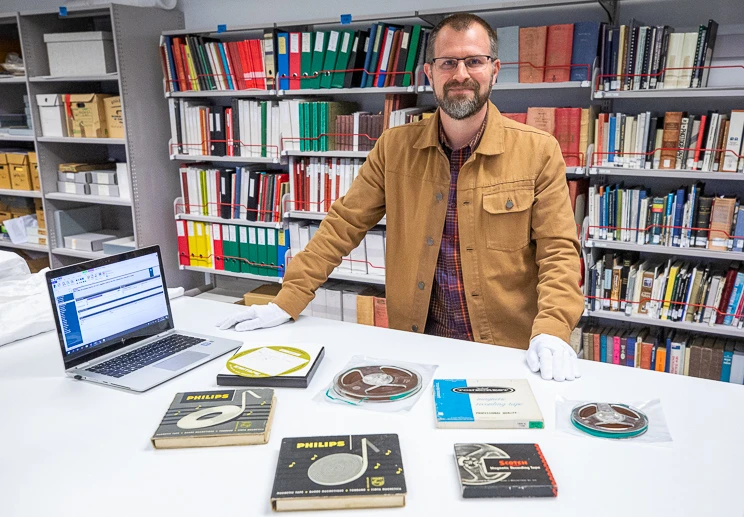
Adam Melville, Research Librarian, Digital Materials, with a selection of recordings by Jim Langabeer. Photograph by Mark Beatty.
Although small, the collection is significant as recordings of jazz music by New Zealand artists from this period are thin on the ground. These five open reel audio tapes come from the late 1960s – mid-1970s when Jim Langabeer was living in Christchurch and they feature some notable names from the city’s music community such as Stu Buchanan, Bob Heinz, Ted Meager, and Richard Nunns.
Until surrogate copies are made, we are unable to listen to analogue audio formats, which is one of the challenges when describing physical material. We must rely solely on information written on the items or from the donor. Thankfully, the tape boxes in the Langabeer collection contain some useful descriptive information – mostly in the form of names and dates. One exception was a 7-inch reel — No 288 Music Box — which will remain a mystery until digitisation takes place. These tapes arrived at the Library too late to be part of the Utaina project, so digitisation will take place in-house.
In the meantime, if you’re interested in hearing some of Jim’s music, his trio is featured on the compilation LP Tauranga Jazz Festival 1968.
Jim Langabeer Trio appears on 'Tauranga Jazz Festival 1968'
For something more recent, I highly recommend his album on Rattle Records, Secret Islands.
Jim Langabeer — Secret Islands, 2017
— Adam Melville, Research Librarian
Dolores Hoy — Te Au Mārie: Mapping Our Stories oral history project for Tuia 250 ki Tai Tokerau, 1769-2019
Making clear the connections between people and collections is at the heart of the work undertaken by the A&D team. Part of this work is making the connections between the “5 Ws” (the who, what, where, when, and why) of collection materials — both in an intellectual and material sense. I had to consider both when working on the born-digital oral history collection Te Au Mārie: Mapping Our Stories oral history project for Tuia 250 ki Tai Tokerau, 1769-2019 (OHColl-1368).
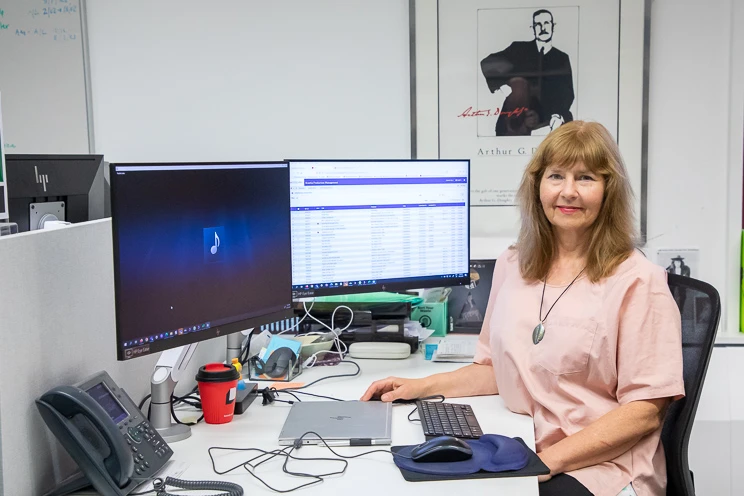
Dolores Hoy, Research Librarian, Digital Materials, working with files from the Te Au Mārie oral history project. Photo by Mark Beatty.
The text and audio materials contain stories of deep personal, family, and cultural connections that are held in separate text and audio-visual digital files. It helps to have an archivist’s input to make those connections clear for researchers.
The oral history collection was commissioned by Te Au Mārie Trust of the Bay of Islands and Te Tai Tokerau Northland as part of commemorations of the 250th anniversary of the first meeting between Māori and British during Captain James Cook’s 1769 voyage to New Zealand.
The interviews record tribal traditions of voyaging waka, sightings or meeting with Abel Tasman, James Cook, Jean Francois Marie de Surville, and Marion du Fresne, and the traditions of waka taua Ngātokimatawhaorua. Interviewees Tā Hekenukumai (Hec) Busby and brothers Joe Conrad and Stanley Conrad are prominent figures in the revival of waka taua and waka hourua and traditions of Māori and Polynesian navigation.
Often when digital files are created, access to that file in the future is not the primary consideration. For example, the file name of a sound file may only be meaningful to the file creator or be a random name assigned by the audio recorder software. Although we don’t want to change the original file names, these are preserved in the National Digital Heritage Archive (NDHA), the 14 sound files named ‘zoom0001’ to ‘zoom0015’ don’t mean much on their own.
But if we add a descriptive title such as ‘Interview with Hec Busby_digital sound recording’ that displays alongside the grouped sound files, we can ensure a researcher knows the name of the interviewee and the file format immediately. Any related text or image files of the interview can have their own descriptive titles too (see OHInt-1368-01), and all files are linked to Tiaki (the Turnbull Archival Catalogue) descriptive and name records.
Our work identifying and organising material and adding conceptual connections helps researchers access the content and context of the collection, and related collections, and ultimately enables good management and easy retrieval of collections over time.
— Dolores Hoy, Reserach Librarian, Digital Materials
Emma Ravenhall — Abhi Chinniah: Material relating to Light Skin Dark Skin and A Migrant's Path exhibitions
In my first year as Research Librarian, Digital Materials, I have had the opportunity to work on a variety of interesting collections. Some contained only analogue material, some only digital, and many were a combination of both analogue and digital material – known as hybrid collections. Abhi Chinniah: Material relating to ‘Light Skin Dark Skin’ and ‘A Migrant's Path’ exhibitions — ATL-Group-00785 is a prime example of a hybrid collection.
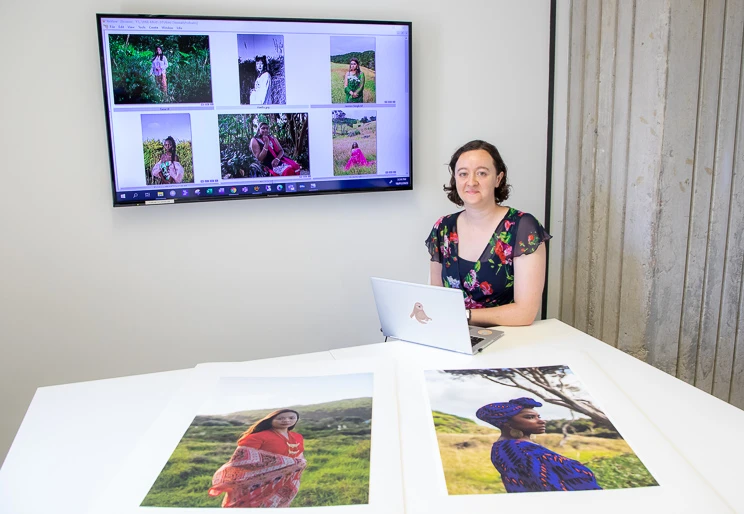
Emma Ravenhall, Research Librarian, Digital Materials, with some portraits made by Abhi Chinniah. Photo by Mark Beatty.
This collection consists of material relating to two photographic exhibitions by Abhi Chinniah – ‘Light Skin Dark Skin’ and ‘A Migrant’s Path’. Much of the material created and compiled for the exhibitions is born-digital, including photographic portraits, audio recordings, essays, email correspondence, and promotional images. Analogue copies were then created of some of the material to display in exhibition spaces, such as the essays and prints of the photographic portraits.
Not only was this a great hybrid collection to work on, but it was also one of the first collections I worked on from the Contemporary Voices and Archives which aims to address silences and gaps in our collections.
Both of Abhi’s exhibitions bring to light the experiences of migrant women of colour in New Zealand, particularly about body image and skin colour. By preserving and describing the material in this collection I hope to make it discoverable to a wider audience and help amplify some of the under-represented voices in Aotearoa.
— Emma Ravenhall, Research Librarian, Digital Materials
Emma Roache — Glory Box collection
The early 1990s was a turbulent time in New Zealand politics. Ruth Richardson’s 1991 budget cut benefits and the Employment Contracts Act ended compulsory unionism. The scene was set for a bit of acerbic fabulousness. Enter Glory Box, a comedy duo who promised to hit “comedy consumers below the belt”. (‘Glory Box Comedy Duo’, promotional flier, MS-Papers-12815-13).
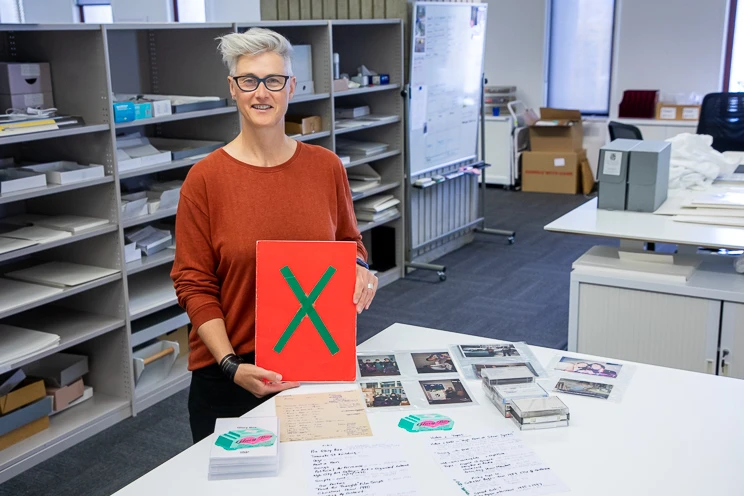
Emma Roache, Research Librarian, holding the Glory Box comedy duo's homemade red and green Christmas songbook. Photo by Mark Beatty.
Glory Box were Pinky Agnew and Therese O’Connell. Both were steeped in the trade union movement, feminism, and unionist songs. In 1990 they decided to make a business out of performance, having spent years entertaining at union gatherings.
As someone new to the Arrangement & Description team it was a delight to work on the Glory Box collection — ATL-Group-00794 recently donated to the Library. Not the least because Agnew and O’Connell had organised it and provided wonderful annotations – for example, the photographs have names and dates written on the reverse, as do cassette tapes of recorded radio interviews.
I was able to create descriptions from the actual words of the donors. When we do this, we make a clear distinction between our descriptions and those provided by a donor.
The annotations also mean researchers may be able to match up song lyrics and a run sheet to a photograph or media report of the actual performance. Some of the run sheets have tape residue on the edges and I imagined the page stuck to the floor between the duo as they performed.
We have their homemade red and green Christmas songbook with their original lyrics to songs like “Away in a Range Rover” and photographs of the duo rehearsing and performing with it in hand.
This variety of material brings a richness to reviewing performances of, for example, ‘The Ruthless Jennies', based on the politicians Ruth Richardson and Jenny Shipley – “they do to you what they are doing to the economy”.’
The collection also captures a particular Wellington milieu. Glory Box shared office space with friend and political cartoonist Trace Hodgson and with the Peace Movement Aotearoa. Hodgson drew the invite to their combined birthday party in 1991 (MS-Papers-12815-09). They hired themselves out as fawning ‘Rent A Fans’ wearing glamorous outfits by Wellington costume designer Janet Dunn. I hope you enjoy this well-rounded overview of a brief but brilliant partnership.
— Emma Roache, Research Librarian
Katrina Tamaira (Ngāti Tūwharetoa) — Te Whaiti family collection
It’s always hard to decide on a ‘favourite’ collection. Do I choose the oldest item or the prettiest, or material about a famous New Zealander? This year I’ve selected material dating from the early 1900s, which also happens to be beautiful, but largely shows unidentified Māori faces, Te Whaiti family collection — ATL-Group-00753

Katrina Tamaira (Ngāti Tūwharetoa), Research Librarian, Māori, with a pair of framed photographs from Te Whaiti family collection. Photo by Mark Beatty.
Early photographs of unnamed Māori intrigue me. In the early years of New Zealand photography, it was common for images of Māori to be traded as curiosities, images that might find their way onto a postcard or decorated plate. As with modern-day marketing imagery, model names aren’t usually included, but what makes these photographs different is the possibility they could be the only surviving image of that person.
These two photographs pictured above were recently discovered by Te Whaiti whānau and deposited with the Library a few months later – ATL-Group-00753. My brain can’t help but ask questions about them – who is the pēpi in the pram, and the young people with poi? Did they go on to live full lives? Am I related to any of them? It’s a timely reminder e te iwi, write names on the backs of your photographs (in pencil) before the memories are lost to time.
— Katrina Tamaira (Ngāti Tūwharetoa), Research Librarian, Māori
Nathan Burgess — Bats Theatre and Downstage Theatre Company collections
Selecting a favourite collection from 2022 is a difficult task when you’ve been processing boxes and boxes of them as fast as possible! I’ve been working on the Utaina project all this year, and though I officially joined the A&D team in October, unpublished audio/visual items are still my primary focus.

Nathan Burgess, Librarian, with just a few of the cassettes and open reel tapes contained in the Bats Theatre and Downstage Theatre Company collections. Photo by Mark Beatty.
The challenge for Utaina A&D is to describe a large number of items quickly, without sacrificing the quality and accuracy of the records. Our goals are preservation (as many of these media formats are nearing the end of their life cycles) and findability for future researchers.
I often get asked if I have to watch each video or listen to each cassette tape in order to describe them – a daunting idea! The scale of the project and the short deadlines mean we couldn’t do that, even if we had the time to create surrogate copies en masse. Our description comes from labels – sometimes easy to read, sometimes not – and other information provided by the donors. We also record technical information that will particularly be of interest to the digitisation team at Avalon Studios.
There have been a few collections that have resonated with me, and that I hope to go back and explore after they’re digitally available. Bats Theatre (MS-Group-0801) and Downstage Theatre Company (ATL-Group-00682) both have collections that include video and audio items that I described. I am very curious about their contents – recordings of plays with names both familiar and unusual, publicity material, soundtracks, sound effects, and more. I’m a theatre kid at heart and love both watching plays and learning how they were produced, and I can’t wait to check these out.
— Nathan Burgess, Librarian
Olive Russell — Associated Theatre Services collection
Kia ora, my name is Olive Russell and I am currently completing an internship with the A&D team as part of my Masters of Museum and Heritage Studies at Te Herenga Waka. While I am here, I’m working on the Associated Theatre Services collection — ATL-Group-00583
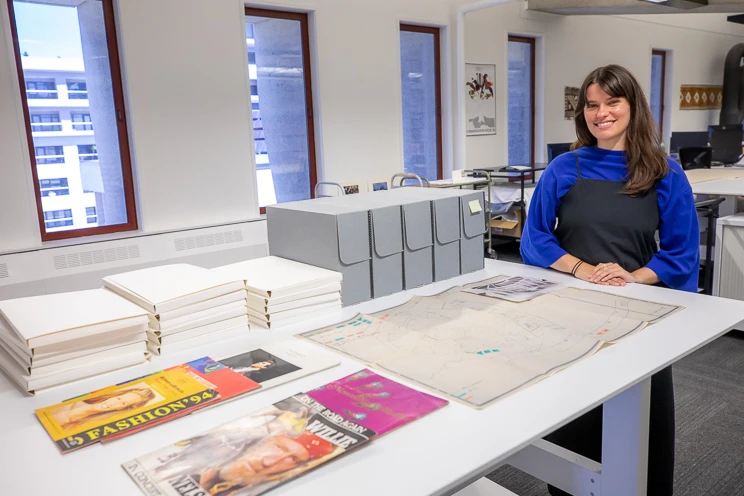
Olive Russell, intern and Masters student of Museum and Heritage Studies at Te Herenga Waka. Photo by Mark Beatty.
This collection contains approximately 250 folders that include correspondence, staging plans and lighting rigs for a touring management company that staged numerous tours of local and international acts across the country from the ‘70s to the early 2000s. My job is to arrange, house and describe the collection so it can be accessible to researchers.
While seemingly a straightforward task, the collection contains numerous oversized folded items that may not have been unfolded since the ‘80s. These require a large amount of space, careful handling and humongous folders. This means that my workbench often looks chaotic, and I’m surrounded by large staging plans for George Michael’s 1988 Faith world tour. The challenge is trying to find a folder that fits on my workbench and is large enough to house them.
So far, highlights from the collection include a Willie Nelson concert programme with impeccable cigarette and whiskey advertising inside, a rider that reveals Joe Jackson needed a ping pong table backstage to combat ‘boredom’, and the company’s transition from fax machine to email, to quote: ‘a carrier pigeon would be easier’.
As glamorous as this may sound, for every Billy Joel folder, there are three car company launches to follow and every folder contains numerous faded 30-year-old faxes that need photocopying for preservation to ensure their longevity, which, on a good day, I might call a labour of love. That said, I’m enjoying getting to know the people who worked for this company, travelling back in time and unpacking their story with each fax and event, piecing together their personalities and learning how their business operated.
I’m very grateful to be working on this unique collection, and within the A&D team, to polish off my Masters, and I can’t wait for this collection to be public so everyone can enjoy its eccentricities. And my photocopying.
— Olive Russell, Intern
Rata Holtslag — Rhoda McWhannell collection
Last year, I worked on some wonderful collections, though I have a firm favourite from the year that was, the Rhoda McWhannell collection. At first blush, this collection appeared to be primarily about forestry and farming (not usually among my best-loved topics), but on further inspection revealed stories of Rhoda’s travels abroad, her relationships with her friends, and the experience of losing her husband, Frederick, after around 60 years of marriage.

Rata Holtslag, Assistant Curator, with a selection of Rhoda McWhannell's handwritten journals. Photo by Mark Beatty.
Rhoda writes in heart-rending detail about the passing of Frederick and the grief that followed – it’s enough to make an archivist cry, safely away from the collection, of course!
The journals are also peppered with entertaining illustrations done by Rhoda, clippings, quotations, greeting cards, and cartoons, among other bits and pieces that reveal much about Rhoda’s character and day-to-day life.
This collection came to the Library several years ago but was not described at the time. Last year, the task to describe the collection was surfaced following a researcher’s request to have most of the volumes digitised. Instead of describing every item in the collection in detail, I enhanced the top-level record and provided a scant descriptions for each of the issuable items.
While this level of description doesn’t provide a great deal of information to researchers, it does facilitate access and use; each of the records includes a standard description of topics covered, as well as date information, enabling researchers to request the volumes that are of most interest to them.
This kind of description also preserves the experience of discovery for researchers, meaning that they get to explore stories like Rhoda’s in the same way that I did: told in her own words.
— Rata Holtslag, Assistant Curator
Sheena Tawera (Ngāti Porou, Ngā Puhi, Ngāti Hine) — Photographic series of exhibition prints: Te Hīkoi o Kāti Kuri: The Journey of Kāti Kuri, 1997
Last year, creating 60 records of exhibition prints for the photographic series Te Hīkoi of Kāti Kuri — Series-6838-2) provided me with an introduction to the work of photographer Anne Noble.
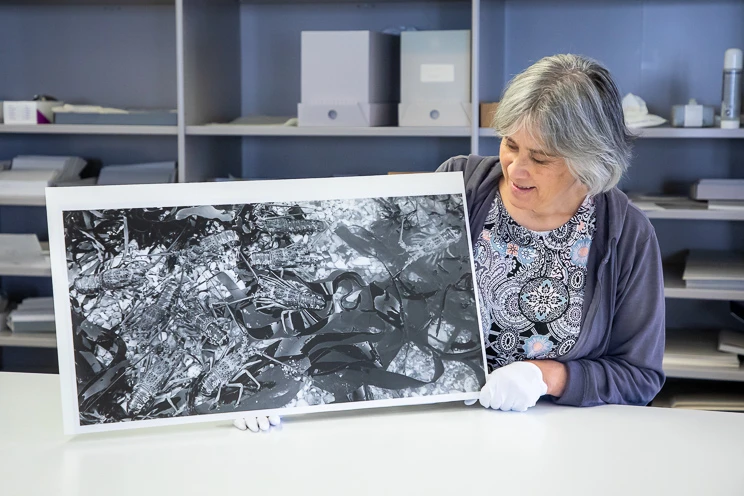
Sheena Tawera (Ngāti Porou, Ngā Puhi, Ngāti Hine), Librarian, with an example of the work of photographer Anne Noble. Photo by Mark Beatty.
The exhibition prints are a subseries of a larger collection: Noble, Anne, 1954-: Exhibition prints, 1992-1997 — ATL-Group-00725), which also comprises photographic works for an exhibition titled Hidden Lives: The work of care. Altogether, the collection contains 121 black and white original photographic prints.
Partially sponsored by the National Library of New Zealand, The Te Hīkoi of Kāti Kuri prints were taken as part of a bicultural art project, and are associated with the regeneration of Takahanga Marae at Kaikōura.
Through her work, Anne Noble records her response to the Kaikōura landscape. When the prints are exhibited in a sequence, they retrace the journey of the Kāti Kuri people from the Wairarapa to Waipapa on the Kaikōura coast.
Initially, transferring the 60 PAColl-D-sized prints from their original exhibition box into their permanent folder enclosures was a challenge at times, due to the large size of each print, which required careful lifting, moving and handling.
However, once housed within their individual enclosures, the prints rewarded my efforts with iconic Wairarapa and Kaikōura images to arrange and describe, including: panoramic Kaikōura landscapes and seascapes; numerous crayfish gathered in rockpools; rimurapa | bullkelp swirling in the tide; dolphins gliding through water; snowcapped mountain ranges framed by mist and cloud; and atmospheric images of storm clouds.
The task I most enjoyed when arranging and describing these prints was identifying and applying Māori subject headings, such as rimurapa, to enhance researcher access to these beautiful images.
— Sheena Tawera (Ngāti Porou, Ngā Puhi, Ngāti Hine), Librarian
William Daymond — Delyn Day collection relating to Andrew Brough and Alistair Galbraith
Forrest Gump famously said in the 1994 film of the same name, “Life is like a box of chocolates, you never know what you are going to get.” The same can be said for being a member of the Arrangement & Description team. Every week is different and the sheer scope of material that comes across our workbenches never ceases to amaze me.
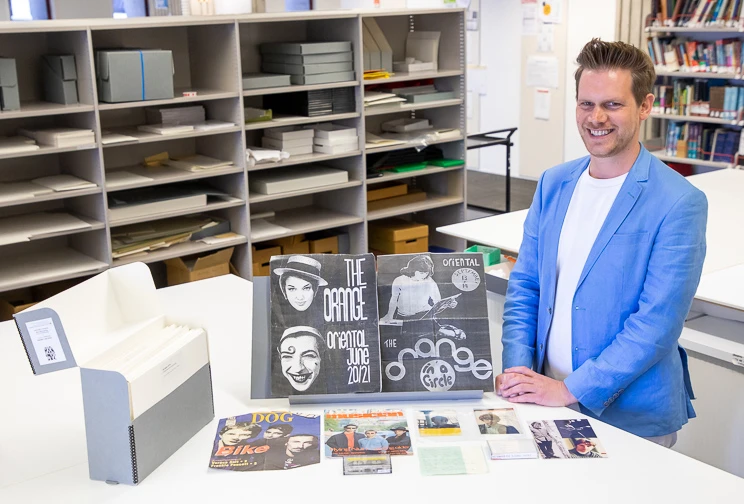
William Daymond, Librarian, with material from the Delyn Day collection. Photo by Mark Beatty.
Last year I processed several fascinating collections, including a battered WW1 nurse’s diary from the front lines of France, three boxes of photographic negatives taken by a speedway aficionado of motocross and stockcars across the North Island during the 1970’s, and nine boxes of concert programmes from Chamber Music New Zealand dating back to the mid 1940’s, including a concert programme from when Thelonious Monk visited New Zealand in 1965.
The personal highlight for me was a collection of predominantly letters donated by Delyn Day — ATL-Group-00696. Delyn was in a relationship with noted Dunedin musicians Alistair Galbraith and Andrew Brough. Brough is most well known for being a guitarist, singer, and songwriter in the band Straitjacket Fits, which during the late 1980s and early 1990’s was one of New Zealand’s more well-known bands on an international scale.
The letters, written between 1985 and 1998, cover the band’s early beginnings in Dunedin, their rise to fame and international touring in the late 1980s, and culminating with being label mates with Aretha Franklin, Whitney Houston, and Kenny G when they signed with US label Arista records in 1990. Brough left the band due to artistic differences in 1991 and by the end of the 1990s had retreated from the music industry; his reasons for doing so are hinted at in some of the later letters to Day.
Brough rarely gave interviews, so these letters giving a heretofore unseen insight into his personality and what it was like to be in one of New Zealand’s most well-known bands, will be of immense value to music researchers.
As well as letters, there are photographs, concert posters, and handwritten lyrics of Brough’s.
Ngā manaakitanga.
— William Daymond, Librarian, Arrangement and Description Team
The A&D Team blogs are always a highlight and this one is particularly gratifying to me as it describes the work Sheena did to give the Kati Kuri images by Anne Noble a permanent home in the collection. keep up the great work and more blogs soon, please.